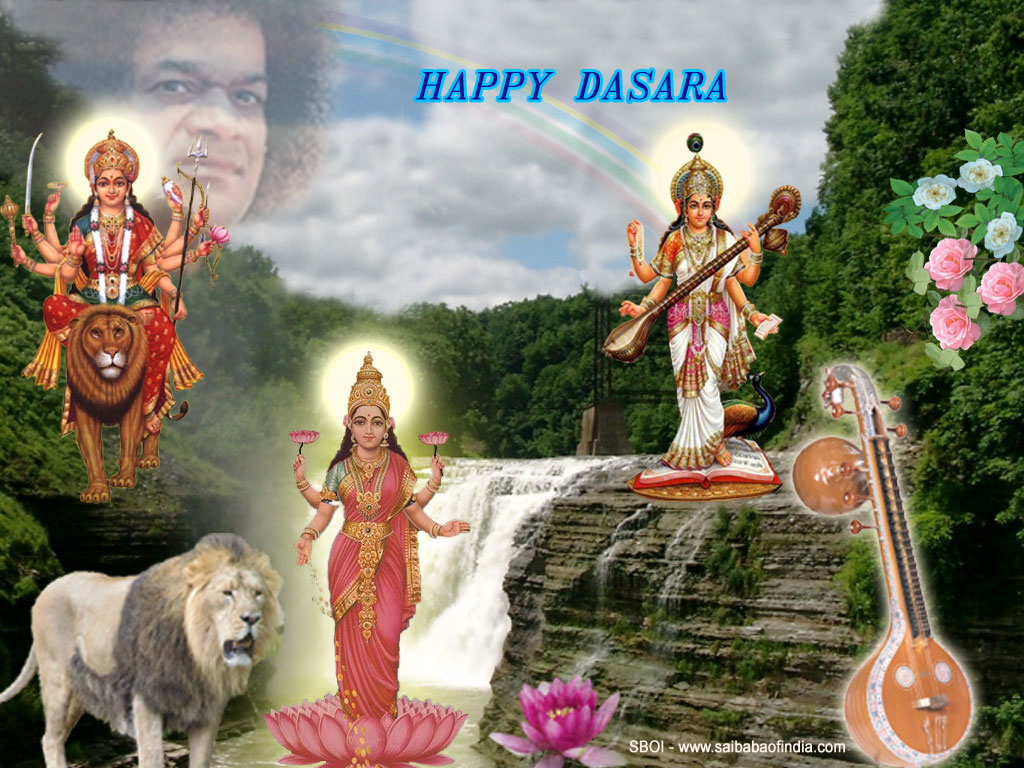 |
| Dussehra Festival, Dussehra Wallpapers, Indian Festival Dussehra |
Dussehra festival falls on the 10th day of the waxing moon during the Hindu month of Ashvin (around September or October). A fascinating collection of mythological legends and regional tales are embroidered around Dussehra. On this day, Lord Rama, killed the unrighteous Ravana, the 10-headed demon king of Lanka who had abducted Rama’s wife, Sita.
It is believed that Lord Rama’s brother Lakshmana, along with an army of monkeys, fought a colossal battle that lasted 10 days. Rama, who was a devout believer of Durga, the Goddess of War, prayed to her for the first nine days of battle and killed the evil Ravana on the 10th day. He shot Ravana with a bow that pierced his navel. Out flowed the nectar of immortality that was stored in a pot in his navel, thus destroying his invincibility. Ravana’s own brother Vibhishana had divulged this secret to Rama. Rama also slew Ravana’s brother Kumbhkarna. Lakshmana killed Ravana’s son, Meghnath. and Dussehra is the festival that commemorates this triumph of Good over Evil. To this day Rama Lila (the enactment of the Ramayana, or literally the saga of Rama) is staged in towns and villages across the length and breadth of the country.
Another legend that is linked to Dussehra is that of the Goddess Durga slaying the buffalo-demon, Mahishasura. According to popular mythology, the gods were compelled to grant Mahishasura indomitable powers for his unparalleled meditation. As expected, the omnipotent buffalo-demon Mahishasura raised hell at the gates of heaven, astounding the gods with his mammoth dominion. The infuriated gods then created Durga. It is believed that Durga was actualised by the combined effort of all deities. Durga possesses a weapon of each god and is said to be more powerful than all of them put together.
In Bengal the festival is known as Durga Puja and is the single most important festival for the Bengalis.
The highlight of Dussehra is Ram Lila. It is enacted for 10 days to mark the 10-day battle fought between Rama and Ravana. Gigantic effigies of Ravana, Kumbhkarna and Meghnath are erected on the fairgrounds. The grotesque and colourful effigies, generally filled with crackers, are set ablaze on Dussehra, or the 10th day of Ram Lila. Huge crowds gather around the burning effigies to enjoy the spectacle. Children are especially delighted at the sight and shoot arrows into the exploding effigies.
Ram Lila is generally held in the evenings, and year after year, people flock in huge numbers to watch the saga unfold, yet once again. In ancient times when it was considered demeaning for women to go up on stage, men performed the female roles. This still happens in most parts of India. Needless to say, the most effeminate and ‘beautiful’ boy is handpicked to enact the role of Sita.
After the Ram Lila and the burning of the effigies of Ravana, Kumbhakarna and Meghnath, the stars of the night Rama, Sita and Lakshmana are taken around in a huge chariot. Crowds of people shouting Jai Shri Ram (Victory to Rama) join the procession.
It is believed that Lord Rama’s brother Lakshmana, along with an army of monkeys, fought a colossal battle that lasted 10 days. Rama, who was a devout believer of Durga, the Goddess of War, prayed to her for the first nine days of battle and killed the evil Ravana on the 10th day. He shot Ravana with a bow that pierced his navel. Out flowed the nectar of immortality that was stored in a pot in his navel, thus destroying his invincibility. Ravana’s own brother Vibhishana had divulged this secret to Rama. Rama also slew Ravana’s brother Kumbhkarna. Lakshmana killed Ravana’s son, Meghnath. and Dussehra is the festival that commemorates this triumph of Good over Evil. To this day Rama Lila (the enactment of the Ramayana, or literally the saga of Rama) is staged in towns and villages across the length and breadth of the country.
Another legend that is linked to Dussehra is that of the Goddess Durga slaying the buffalo-demon, Mahishasura. According to popular mythology, the gods were compelled to grant Mahishasura indomitable powers for his unparalleled meditation. As expected, the omnipotent buffalo-demon Mahishasura raised hell at the gates of heaven, astounding the gods with his mammoth dominion. The infuriated gods then created Durga. It is believed that Durga was actualised by the combined effort of all deities. Durga possesses a weapon of each god and is said to be more powerful than all of them put together.
In Bengal the festival is known as Durga Puja and is the single most important festival for the Bengalis.
The highlight of Dussehra is Ram Lila. It is enacted for 10 days to mark the 10-day battle fought between Rama and Ravana. Gigantic effigies of Ravana, Kumbhkarna and Meghnath are erected on the fairgrounds. The grotesque and colourful effigies, generally filled with crackers, are set ablaze on Dussehra, or the 10th day of Ram Lila. Huge crowds gather around the burning effigies to enjoy the spectacle. Children are especially delighted at the sight and shoot arrows into the exploding effigies.
Ram Lila is generally held in the evenings, and year after year, people flock in huge numbers to watch the saga unfold, yet once again. In ancient times when it was considered demeaning for women to go up on stage, men performed the female roles. This still happens in most parts of India. Needless to say, the most effeminate and ‘beautiful’ boy is handpicked to enact the role of Sita.
After the Ram Lila and the burning of the effigies of Ravana, Kumbhakarna and Meghnath, the stars of the night Rama, Sita and Lakshmana are taken around in a huge chariot. Crowds of people shouting Jai Shri Ram (Victory to Rama) join the procession.